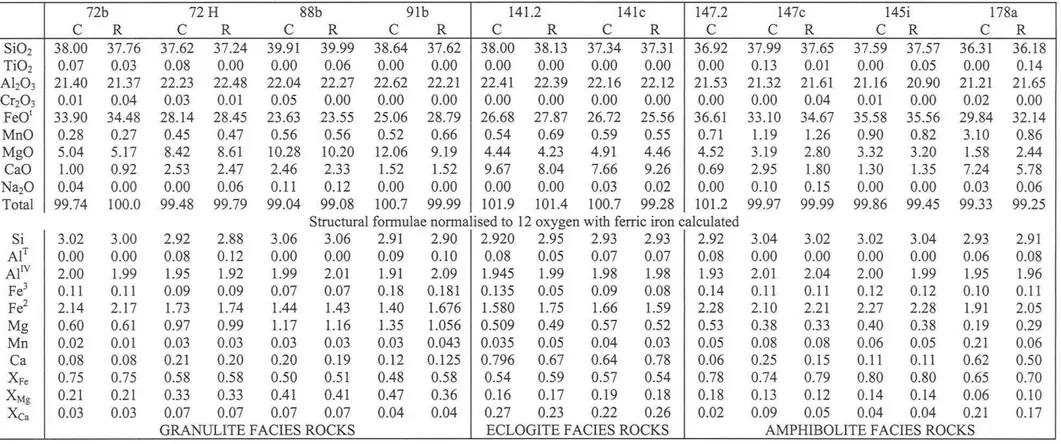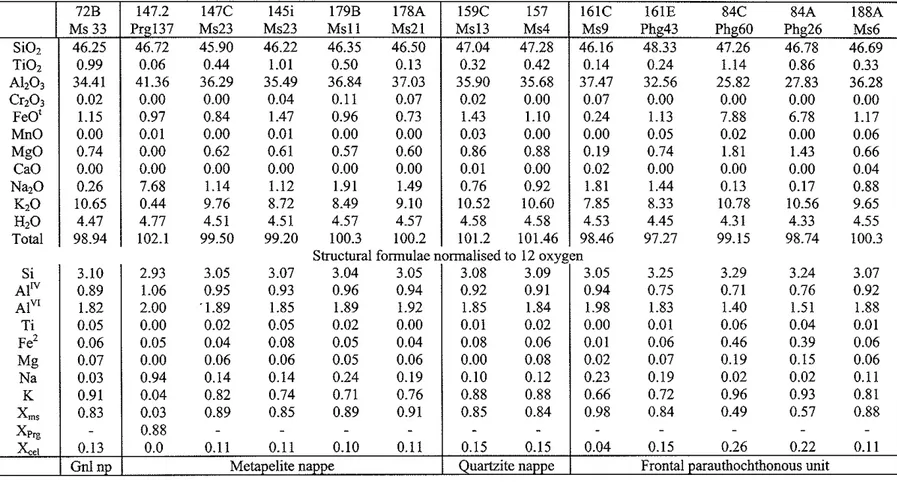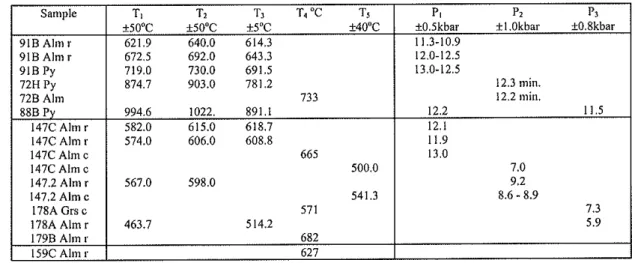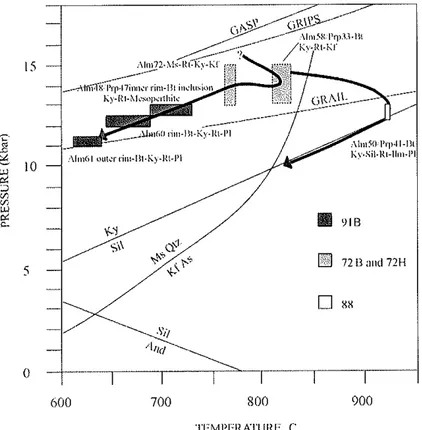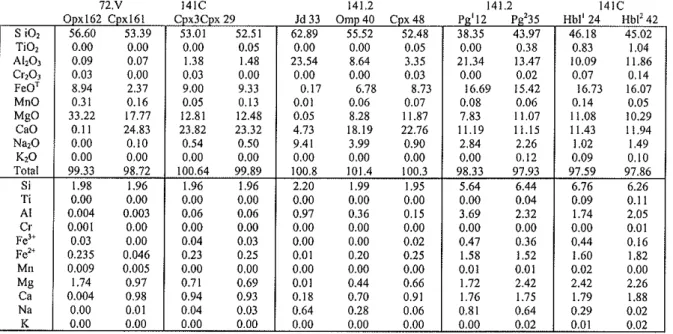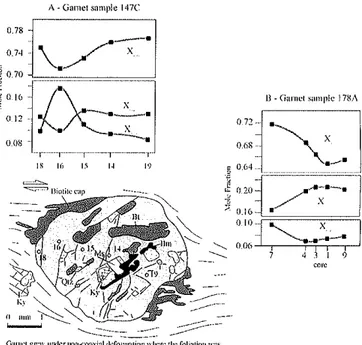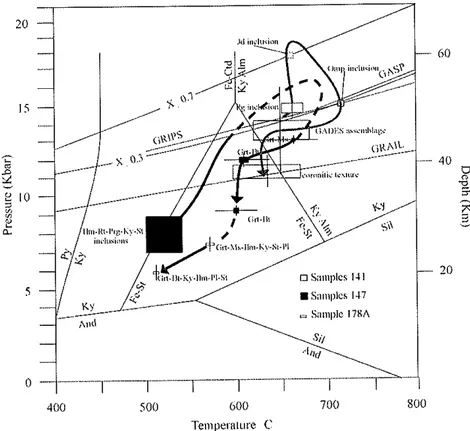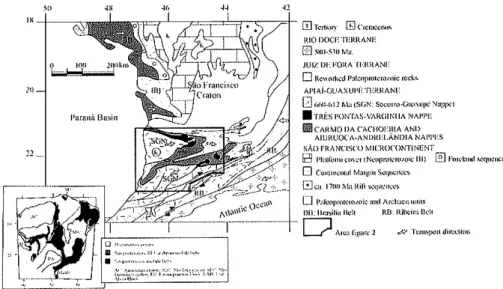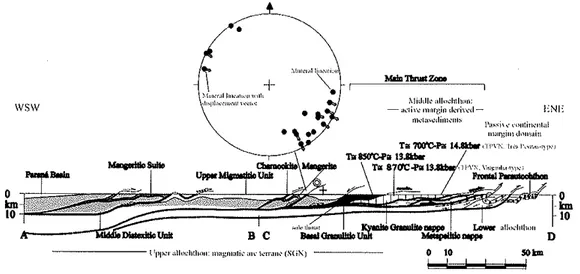INSTITUTO
DE
GEOCIÊNCIAS
EXTENsAo
suL
Do stsrEMA
oRocÊtr¡lco
TocANTTNS
No coNTEXTo
cEoDlruÂMlco
DA
AGLUTTneçÃo
Do
coNDwANA:
ExEncíclo
DE
recrôNIcA
Mario
da
Costa Campos
Neto
Tese apresentada
pôra
o
Concurso
deLivre-Docência
junto ao
Departamento deMineralogia
e
Geotectônicado
lnstitutode
Geociências
da
Universidade
deSeo
Paulo.
Ár""
de
Conhecimento:de
Geologia Estrutural/Geotectônica.SAO
PAULO
INSTITUTO
DE
GEOCIÊNCIAS
EXTENSÃO
SUl, DO
SISTEMA OnOCÊNICO TOCANTINS
NO
CONTEXTO GEODINÂMICO DA
AGLUTINAÇ^Ã'O DO
GONDWANA: EXERCÍCIO
DE
TECTÔNIC¡,
Mario
da Costa Campos NetoTese
apresentadapara
o
Concurso
de
Livre-Docência
junto
ao Departamento de Mineralogia eGeotectônica
do
Instituto
de
Geociências daUniversidade de São Paulo. ,4,rea de conhecimento
de Geologia Estrutural/Geotectônica.
SÃO
PAULO
t999
DEDALUS-Acervo-tGC
ilililtililililtilililililililililililililililililtililill
CAPÍTULO
1-
BREVE APRESENTAçÃ,O
CAPÍTULO
2-
NEOPROTEROZOIC
HIGH-PRESSUREMETAMORPHISM
AND
TECTONIC
CONSTRAINT
FROM
THE
NAPPESYSTEM SOUTH
OF THE
SÃO
FRANCISCO CRATON,
SOUTHEAST
BRAZIL
Abstract
2'1 . Introduction
2-2. Geological setting
2-2.1. The Socorro-Guaxupó nappe
2-3. The kyanite-granulite nappe 2-3.1. Lithology
2-3.2. Kinematics
2-3.3. Microstructures and mineral assemblages 2-3.4. Mineral chemistry and P/T estimation
2-4. The metapelite nappe complex
2-4. 1 Petrology of eclogitic rocks and kyanite metapelites
2-4.2. P-t estimates
2-5. The quartzite nappe complex
2-6. The parautochthonous unit
2-7. Discussion
2-8. Conclusion
Acknowledgements
3
4
5
6 6 8 9 10
T6
I7
18
20
22
22
23
24
CAPÍTULO
3-
TERRANE
ACCRETION AND
UP\ryARDEXTRUSION
OFHIGH-PRESSURE
GRANULITES
IN
THE
NEOPROTEROZOIC NAPPES OF' SOUTHEAST
BRAZIL:
PETROLOGIC AND STRUCTURAL CONSTRAINTS
Abstract
3 - 1 . Introduction
3-2. Geological setting
z5
3-3.1.1 The Basal Granulitic
Unit
3-3.1.2. The Middle Diatexitic
Unit
3-3.1.3. The Upper Migmatitic
Unit
3-3. 1.4. The syn-kinematic plutonic intrusives
3-3.2.
The Três Pontas-Varginha nappe3-4.
Nappe geometry, kinematics and metamorphicevolution
303-4.1.
The Socono-Guaxupé nappe(SGN)
313-4.1.1.
Basal solethrust
323-4.1.2.
Syn-metamorphicnormal
shearing
and
late-metamorphic NE-directthrusting
333-4.1.3.
P/T estimation forSGN
343-4.2.
The Três Pontas-Varginha nappe(TP\'rÐ
343-4.2.1
.
Microstructures ofkyanite-granulites
353-4.2.2.
Successivemineral
assemblagesand
P/T
estimatesof
Kyanite
andsìllimanite
granulites
353-4.3.
The southemshear-belt
403-5.
Age constraints on high-grade metamorphism and nappeemplacement
4l
3-6.
Summary of data anddiscussion
423-7.
Conclusion
44Acknowledgement
45CAPÍTULO
4
-
OROGENIC SYSTDM
FROM
SW-GONDWANA:
AN
APPROACH TO BRA,SILIANO-PAN AF'RICAN CYCLE
AND OROGENIC COLLAGE IN SE-BRAZIL
Abstract
4-1. Introduction
4-2. Major continental plates
framework
474-2.1, Statherian taphrogeny: attempts to break-up
ofthe
São Franciscoplate
484-3. Fragments ofRodinia
history
494-3.1. The Central Goiás
tenane
494-3.2.The
Apiaíteffane
524-4.The São Francisco plate margins: paleotectonic
approach
554-5. The Tocantins orogenic
system
584-5.2. 1. The upper high-temperature Socorro-Guaxupé nappe 4-5.2.2. The high-pressure napPes
4-5.2.3. The meddium-pressure lower nappes and foreland orogen propagation
4-5.3. Tectonic evolution
ofthe
Southem Tocantins orogenic system4-6. Paleotectonic approach for the Mantiqueira orogenic system
4-7 . The Mantiqueira orogenic
system
724-7.1.
Regionalview
on plate convergencein
the Southem Mantiqueira orogenicsystem
72q-l
.2.
ihe
Central and Northern segments ofthe
Mantiqueira orogenic system 734-'7.2.I.
Late-orogenicbasins
784-7.2.2.
Post-orogenic transition from compressive to extensionalcollapse
784-7
.3.
General framework: the Rìbeirabelt
794-8.
From Rodinia to Gondwana: SE-Brazil geodynamicevolution
80REF'ERENCIAS
BIBLIOGRÁF'ICAS
62 65 66 67
CAPÍTULO
1BREVE
APRESENTAçÃO
Essa tese de
Livre
Docência resulta da sistematização científica empreendida nosanos
de
1998e de
1999. Alicerçadaem
trabalhosde
campo sistemáticos,na
análiseestrutural e na petrologia metamórfica como femamentas básicas, aliadas ao manuseio do
acêrvo isotópico e geocronológico, ela possui na análise tectônica seu principal vetor de
direção.
No
entanto, pressionado pela Reitoria da Universidadede
Sãopaulo
através dacomissão Especial de Regimes de Trabalho (GERT) e pelas principais agências nacionais e
estadual de fomento à pesquisa, deu-se prioridade à preparação de artigos endereçados à
comunidade científica internacional, antecedendo
a
formulação irrtegrada em uma tese.Assim, quatro trabalhos foram preparados, três para as revistas precatnbrian Research, Tectonics e Episodes (ver referências bibliográhcas) e um para o Livro Tectonic Evolution
of
south America, a ser editado pelo 31o congresso Geológico Internacional. Destes, os dois
primeiros (preparados com
a
colaboração doDr.
Renaudcaby, Diretor
de pesquisas doCNRS, França) e o ultimo constituem o corpo desta tese. São eles:
Campos Neto,
M.C.
e Caby,R.,
1999. Neoproterozoic high-pressure metamorphism andtectonic constraint
from
the nappe system southof
the São Francisco Craton, southeast Brazil . Precambrian Research, gj , 3-26.Campos Neto, M.C. e Caby, R. (inédito). Terrane accretion and upward extrusion of
high-pressure granulites in the Neoproterozoic nappes of southeast Brazil: petrologic
and estructural constraints. Tectonics (aceito para publicação).
Campos
Neto, M.C. (inédito).
Orogenic systemsfrom
SW-Gondwana:an
approach toBrasiliano-Pan African
cycle
and orogenic collagein
SE-Brazil. E.J.Milani
eA.
ThomazFilho
(edts.) Tectonic Evolutionof
South America, International(Jnion
of
Geological Science-3ltt'
InÍernational Geological
Congress(submetido).
O
tempo, constrangidoa
prazos rígidos, não permitiu que esses trabalhos fossemreescritos em poftuguês e integrados no contexto da tese.
por
estemotivo
ela está sendoapresentada
em
inglês.
cada
trabalho
conespondea um
capítulo,
respeitadaa
suaintegridade, do
título
aos agradecimentos. As referências bibliográficas foram unificadas eas f,rguras renumeradas de acordo com os capítulos.
Como são artigos que se complernentam, a ordenação dos capítulos permite, sem quebras maiores no encadeamento do texto, uma visão geral, dos objetos (ou dados obtidos)
aos processos e a integração destes na dinâmica global. Essa relação entre os artigos, aliada ao fato de dois deles ainda não terem sido publicados, garante o caráter inédito desta tese.
O Capítulo
2
trata do sistema de nappes que se empilham lateralmente à borda suldo cráton do São Francisco. Distingue nessas estruturas, padrões cinemáticos diferenciados
e
trajetórias metamórficas conflitantes.A
enfase estános
alóctones inferiores, onde odo
orógeno como resultanteda
extrusão forçadae
debaixo
ângulo,de um
prisma desubducção continental, grosseiramente orientado para oeste.
A
ênfase do Capítulo3
está nas nappes superiores, de alta temperahlra, colocadas em evidência, inicialmente, por campos Neto et al. (1984). são teruenos identificados comum ambiente de raiz de arco magmático, cujo registro metamórfico e estrutural
assernelha-se
a
um
orógenocolisional
himalaiano.o
registro químico
e
isotópico
apresentado, reforçado no trabalho de Janasi (1999), alia-se aos distintos ambientes tectônicos deduzidos pelas incompatibilidades e diferenças nas trajetórias metamórficas, permitindo um avançono reconhecimento de terrenos, ou de ambientes tectônicos exóticos em relação a placa do
São Francisco.
A
evolução
geodinâmica apresentadano
Capítulo
4
discute
o
processo deaglutinação do sudeste do continente brasileiro dentro do contexto da colageln orogênica
do sudoeste do Gondwana. Parte-se dos registros, na região, dos processoì de quðbra e
dispersão
de
Rodínia,de
interação de placas oceânicase
do
diaõronismo dos iegimesNEOPROTEROZOTC HIGH-PRESSURE
METAMORPHISM AND TECTONIC
CONSTRAINT
F'ROM NAPPE SYSTEM SOUTH OFTHE
SÃOFRANCISCO
CRATON,
SOUTHEASTBRAZIL
Abstract
The Neoproterozoic giant nappe system exposed south
of
the São Francisco cratonunderwent
a minimum
of
150km
of
near-horizontal northeastward displacement. Thisnappe system comprises an uppermost
unit
derivedfrom
a plutonic magmatic arc terranewith
high-pressure, high{emperature intermediate to mafic granulites at its base(Socorro-Guaxupé nappe), underlain
in
sequenceby a
high-pressure kyanite granulite nappe, anamphibolite facies metapelite nappe, and
finally
by
a
quaúzite nappewhich
forms the lowest paú of the pile and rests on a parautochthonous unit related to the passive marginof
the craton .The kyanite granulites crystallised around 13 kbar,
750'c
and have only ai theirtop sillimanite related to T-increase overprinting
(T=890'c),
a consequenceof
downwardheat advection
from
the overlying
socomo-Guaxupé granulites equilibratedat
900oc.Pressures
of
13-14
kbar
are
documentedin
the
underlying
metapelite nappe withtemperatures
of
640-670"c,in which
lensesof
eclogite indicate pmaxof
ca.
17.5 kbar.Phyllites
of
the parautochthonousunit
are directly overlainby Hp
granulitesin
the norlh and record P^, 7 kbar andr:
500"c. The distribution of metamorphic facies is reminiscentof
inverted metamorphismwith
eclogitesfrom
subduction-related metamorphism andkyanite granulites
from
early extrusionof
subducted continental crust. The metamorphicconditions
of
the parautochthon may represent a stage achieved during late metamorphicthinning
of
the
nappe
pile.
The
overall picture
suggeststhat
high-pressure unitsrecrystallised
in
a subduction zone located to thewsw.
Thefrontal
thrustsof
the nappe system show a late, north northeastward transported thin-skinned pattern.Keywords:
Brasiliar/Pan-African;
collision
tectonics;
nappe system;
high-pressuremetamorphism; kyanite granulite.
2-1.
Introduction
Most
granulites formed
in
the
lower
crust
of
collisional
orogens generallyunderwent late-kinematic recrystallisation because they were eventually maintained during a long time at elevated temperatures close to hot mantle. Sillimanite kinzigites are normal
end products
of
most
nretapelitic granulites formedwithin
the lower crust
of
formermountain roots. The exhumation
of
the lower crust either resultsfrom
regional extensionand/or asthenospheric doming (i.e. Permian-Mesozoic exhumation of the rwea zone,
zinng
et al., 1990).
In
himalayan'type
collisions
that
generally
result
from
continuous
plate convergence and continental subduction, the lower crustis
exposed throughpiling-up
of
crystalline nappes displaced 100 km or more over less metamorphic allochthons, giving rise
earlier
higher pressuremineral
assemblages.In
central Himalayamaximum
pressuresaround 9 kbar have been calculated
for
most metapelitesby
Vannay and Hodges (1996),with
valuesup
to
12kbar
in
Langtang (Macfarlane, 1995). Indeed,the
occurrenceof
kyanite in the primary assemblage
of
metapelites associatedwith dry
leucosomes towardsthe base of the main crystalline allochthon in central Nepal
(caby
etal.,
1983) leads to the assumption that much higher pressure rocks may be present at depths. Such is the caseof
noúhern
Pakistanwhere
high-pressure metapelites(650-700"c and 8-13 kbar)
were exhumated under decreasing temperaturesin
the kyanitestability field
(pognanteet
al.,1993). Also
lensesof
medium-temperature eclogites survived enclosedin
gneisses and metatexites (Pognante and Spencer, 1991; Tonarini etal.,
1993; LeFoft et al,
1997).Liu
and' zhong (1997) bave described in eastem Himalaya relics of high-pressure granulites.
In
the Tso Morari dome at the North Himalayan Massif a high-pressure and low-temperature
mafic and pelitic eclogites was recently described, implying
in
a continental subduction at the onsetofthe
Indian-Eurasian collision (Guillot et al., 199'7 and Sigoyer etal.,19gi).
slightly
retrogressedmafic
eclogiteswith
preservedlow
to
medium-temperatureprograde minerals such
as
lawsonite have been reported elsewherein
granulites andanatectic metapelites
(Biino,
1994), showing
that
early
high-pressure metamorphicconditions may survive retrogression even at high temperatures. There are however very
few
examplesof
outcroppingslightly
or
unretrogressed kyanite granulites (seepin
andvielzeuf,
1983). The occurrencesof
kyanite granulites described areall
associated with eclogitesbut kyanite
is
invariably
overgrownby
sillimanite as
in
the Iberian
massif(Ibarguchi
et
al.,
1990; Arenas, 1991; Abaloset
al,
1996)or
in
the
Bohemian massif(carswell and
o'Brien,
1993).In
contrast, kyanite is the only Al-silicate present in rocksadjacent
to all
reportedultra
high-pressure rocksin
the world. This may
suggest thatsubduction settings
with
low
geothermal gradients(<12'cl
km)
representthe õnly
sitewhere
high-pressuregranulites
can form
and
be
exhumed
rapidly, thus
escapingreequilibration in the sillimanite stability field.
_
we
describe in this paper the tectonic setting and metamorphic evolution of kyanitekinzigites and associated rocks that form the base of himalayan+ype nappes with associated
reverse metamorphism
in
the Neoproterozoic Brasiliano belt, southof
the são Francisco craton. We then discuss tho tectonic implication of the reconstructed P/T paths of granulitesand
adjacentsunits and
we
proposea
scenariofor
nappestacking and
exhumationaccording to the available U-Pb and Sm-Nd geochronological data.
2-2. Geological setting
The Archaean-Paleoproterozoic São Francisco Craton
in
SEBrazil (Fig.
2-l)
isbounded
in
its
western and southern marginsby
nappesinvolving
proterozoiðrift
andcontinental margin sequences (Brasília and
Alto
Rio Grande belts,Brito
Neves etal,
i995;Paciullo et
al.,
1998).It
comprises from top to bottom: a giant high{emperaturegranulite-migmatitic
allochthon(the
socoro-Guaxupé nappe)that
is
part
of
the
Apiai-buaxupé terane (Campos Neto and Figueiredo, 1995); an upper kyanite-granulite nappewith
high_ pressure metamorphism (Vasconcellos, ef al. 1991; Trouw, 1992; Trouw and Castro, 1996; Campos Neto and Caby,1997, Trouw et al., 1998); a lower metapelite nappe withmedium-temperature, high-pressure metamorphism;
a
qluartzite nappewith
passive continentalmargin
affinity
(Ribeiro etal.,
1995), and a parautochthonousunit
overlying the southernsouth
ofthe
são Francisco craton is the extension of the Brasilia belt (Trouwet
al.,l9g4a;
Fuck et
al.,
1994; Valeriano eLal,
1995 and 1998; Simões, 1995; Seer etal,
l99g).
The nappes that underlie the Socoro-Guaxupé nappe have been named the"Alto Rio
Grandebelt" and their lithostratigraphy, structure and metamorphism vr'ere first studied by Trouw et
al. (1980,
1982, 1983, 1984b, 1986),Ribeiro
and Heibron (1982), CamposNeto et
al.(1990), Junho er al. (1992), and Ribeiro et al. (1995). The nappe system is bounded to the southeast
by
major
synto
late-metamorphic shear zonesthat
were activetill
570
Ma(Machado er al., 1996).
lrlr"u.'
ß] c,"r".**E sro-s¡or¡"
ll Rù, orkùl P¡tcÕr)r'r(r¡/¡rc mclf
[¡.r,04r] rvrr (s(jN: rjoèo¡î-or¡\ori NrDrtr)
I xr¡rllr, c¡¡i.rt ¡.r lr:r¡¡,¡l &9 itrr¡r,rl nr:x¡r,r,r'
sio r.lANcrsto ñr( ìoaoNl tNtiNl
E Ptirtiùùco\ù, (Ncoùlrc,o/¡ic tl) þjt,odt¡nd sqrcN(
l:] ( ùniN :f Mùrid sùtrcnñs
E cr. l?rìrrñl l{ifi scqtrctrrcs
lll]: ll[¡lr I]clt AltCll
^ho ttro cr¡ùdc tJctr
J l r'..,r'lj*. , á rh \Do¡ d"c.,otr
| | \ r,r'rcrr¡or,r
Silo |rùc¡oo cr.tron [o kl¡n.rncr
^ knùr ñ tirl(|o ( t98$l
Figure2-1: Sketch tectonic map ofSoutheast Brazil.
2-2,1 The Socorro-Guaxupé nappe
_
The Socorro-Guaxupé nappe comprises aflatJying
to gently southwestward dippingsole
of
enderbitic granulites ca.3 km thick.
These granulites grade upwardinto
gÇ
topink,
biotite-homblende diatexites ca6 km thick
interlayered attheir
topwith
p"ìiti.
tosemi-pelitic
migmatitesand
subordinate lensesof
qvartzite, calc-silicãte gnóiss,.a."
marbles and mafic metaintrusives. Peraluminous muscovite-bearing granites intnrde the top
of
the
allochthon(Fig. 2-2). The
basal green-colored, medium-giained, garnet bearing banded granulites of enderbitic modal composition are metaluminous,low-K
rocks ofcalc-alkaline
affinity with
lower amountsof
large ion lithophile elements (campos Neto et al., 1996) than the other granulitic plutonic rocks of the nappe unit (Fernandes et al., 19g7; Iyeret
al., 1996). The anhydrous enderbitic light-coloured leucosomes and the coarse-grainedgrey
to
pink
hololeucocratic chamockiteveins are
interpretedas
in
situ dry
melts.Decimetre-thick dark gabbro-noritic layers considered as syn-metamorphic
intruiives
arecommon. The Neoproterozoic age of granulitic metamorphism is constrained by
a
629+
14Ma
sm-Nd
garnet-biotite-wholerock
isochron agefrom
a
granulite samplefrom
thePiranguirho
quany (Fig. 2-3,
Teixeira,written
communication,data
from
centro
dePesquisas Geocronológicas, universidade de são paulo,
Brazil).
The protolithsof
theseenderbitic granulites give a Sm,t{d T¿n, model age
of
1290Ma, with
eN¿ (0.640)=
_1.2.These results are in agreement with the isotopic primitive cornposition of the Mara Rosa arc
in the hinterland of the Brasilia belt, where the main metamorphism also took place around
zircon method (Basei et
al,
1995) grade upwardinto
biotite-hornblende granitoids, bothrock types exhibiting porphyritic texture. The granitoids
with
ahigh-K
calc-alkaline trendwere emplaced as syn-metamorphic batholiths (630-625
Ma,
Ebertet
al., 1996; Töpfner,1996) and are coeval with stratoid mangerites (Campos Neto et al., 1988; Janasi, 1997).
Fìgllfe 2-2: Schematic cross-section of Socor.ro-Guaxupé nappe.
The basal
granulitesare
characterisedby
garnetclinopyroxene-orthopyroxene-plagioclase-quarlz assemblages
in
mafic
rocks and
garnet-sillimanite-cordierite-greenspinel-biotite-plagioclase-quartz
as
reequilibrated assemblagein
metapelites. Previouspetrologic studies
(Table
2-1)
point
to
initial
high-pressure,
high{emperaturemetamorphism at
P:
12.5 Kbar,T:
900oC followedby
partial reequilibration aIP=
7.5Kkar
andT=
850oC. Only high temperature-low pressure conditìons prevail on the topof
the nappe.TabÌe 2-l: Sunrmary of thermobarometric data of Socorro-Guaxupé terrane, Mineral name al¡breviations
from Kretz (1983).
The whole Socorro-Guaxupé nappe maintained a near horizontal foliation, and the
ENE trending lineations
with
E-directed shear sense indicators throughout the nappe arguefor its eastward displacement (around 200 km, Fig.2-3). To the south, a major NE{rending
dextral shear belt truncates the Socorro-Guaxupé nappe. Syn-metamorphic structures in the
nappe are cut by undeformed circular high-K diorite to syenitic plutons emplaced at ca.10
km depth (Janasi et al, 1993) at 612 Ma (Töpfner, 1996) fltaT belong to ultrapotassic suites.
An alkaline intrusive suite adjacent to a graben
filled
wjth molassic and voicanic sequences(ca. 600 Ma, Siga Jr. et
al,
1995) at the southwestern boundary of Apiaí-Guaxupé Terrane also reflect this last extensional regime.2-3. The
kyanite-granulite
nappe2-3.1
Lithology
E
MAIN MINERAI,Grt-Crd-Sil-Bt-P1-Grr-Crd-Sil- Br-spl-PI-Kfs
Grt-Cpx-Pl-Qzt Grt-Cpx-Hb1-Bt-Pl-Qzt
4.5 7.5 8.5
t2.5 t2.0
820 850
8s0
900 890
Vasconcellos et al, l99l
Oliveira & Rube¡ti, 1979
Iyer et al, 1996
This ca. 5 km thick high-pressure nappe comprises mainly coarse-grained
kyanite-garnet granulites
with
lesser amountsof
kyanite quartzites, impure quartzites,few
calc-silicate rocks and garnet- rich quarlzites. The
typical
granulites are derived from potassic,SO(OI¡llO.GUÀ\L'l,l NÀl,r,l: rSairì
r-]{.1¡til,l.lsßv
r.,rÉT pÈLtìEN^t,pt!aoÑpLr-¡" (NItr¡ ot.^tìt/Íj\at,t,tj(atr)
E,¡Ll,,!,
[J rn'
.//'.
...,'1.,-+ì,
!4.r,
llzr I
þl r? Ll,sE,q
ll:¡r lllr, ,'
'Ì nst¡nr¡L¡ocrn'ì Ò ., ,\n liscd s rrflc
Figure 2-3: Geological map ofnappe system South ofSão Flancisco craton
l, Cretaceous,2.Tefiary,3. plutonic rocks (ca.595-570 Ma),4. tourmali're-bearing g¡anitcs. Socorro-Guaxupé nåÞper 5, high-K
cAlc-âlkaline graniloids (ca.630 Ma),6. $chist belt,7, pâragneisses and migmatites, S. grauite-mignlalite complex,9, granulites.
Kyanite-Granulrte nappe (KGN): 10, sillinìânile-kyanile migmat¡les,
Il.
kyanite grâDulite, 12. mctabasic-quarlzitic association. Metâpelitc nappe conplex (Mpn): 13. metapelrtes, 14, metågreywackes, 15. kyanite-bearing mignrati(es.Quafzile nappo (Qn)r 16, quaÍzitic-schist assemblage, F¡onlal Para-autochthonous units: 17. interbedded quâlzites and
phyllites, Southeln and Eastem domai s: 18. metavolcanosedimentary sequence, 19. migmatite le¡rain. Archaean-Paleoproterozoic: 20. orthogneisses, m¡gmatites and metåmafic-ultrânâlìc sequence. Ju¡z de Fora tonane: 21.
Paleoprotcrozoic reworked enderb jtes.
hyper-Al
and Ca-poor pelites (Três Pontastype). This
sequencedevoid
of
significantretrogression grades upward into sillimanite-gamet granulites (Varginha-type) approaching the basal contact of the Socomo-Guaxupé nappe (Fig. 2-4).
At
Tres Pontas, these granulitesform a
moderately boudinaged sequencein
which the
compositional layering inheritedfrom
sedimentary beddingis
outlinedby
the variable proportionof
kyanite, garnet andminor micaceous layers. Layers a few centimetres thick with up to 80% of gamet, others a
few millimetres thick
with
kyanite as the main mineral, grey quartzites, various amphiboleand calc-silicate-bearing rocks, and rare mafic/ultramafic rocks are intercalated
within
themain kyanite-garnet granulite type. To the south two klippen made up
of
the same kyanitegranulites are preserved, thus arguing for a minimum
of
100 kmof
eastward displacementof the nappe (Fig. 2-
I
and 2-3). One Sm/Nd whole-rock from a kyanite granulite of the TrêsPontas
and one from the
Varginhatypes give
T¿nmodel
agesof
1.4
and
1.55 Garespectively
with
e^o (0.625)of
-3.6
and-2.1
(Janasi verbal communication, data fromIsotope Research Laboratory, Kansas University, USA). Such values seems to indicate that
terrigenous cover ofSão Francisco craton, and had active continental margin characteristics
(Mclennan et al., 1990).
llofì lc pl¡ìrc ol oylindric¡1
rìjìpPc ë 2
Mclapclilc nrÌDc
-' Sirnrplcs rìlh )L l orinìrl(
Frgure2-4: Cross-section of kyanite-granulite nappe and Carmo da Cachoeira nappe with equal-area
stereographic lower hemisphere projection of mine¡al and stretching lineations.
9l
aDalyscd sample for P-T.2-3.2 Kinematics
The main structural pattem is similar to that
of
the Socorro-Guaxupé nappe and is characferized by a sub-horizontal foliation. ENE trending mineral and stretching lìneations(kyanite,
rutile, white
mica, quartz ribbons,Fig.
2-4), whereasin
the Carvalhos Klippenlineations are oriented
E-W
(Fig.2-5).
The
most common structures are asymmetrical boudins (up to 5 m long) even in metapelites of similar rheology, and rare interfolial folds.The ENE direction
of
ductileflow
is evidencedby
asymmetric structures such as wingedporphyroclasts, decimetric metabasic swells
of
pull-apart type and small isoclinal a-typefolds.
Mylonitic
bands are associatedwith
in-plane type winged porphyroclasts and tightsmall-scale folds with stretched limbs.
o Slrùlched nnd rììirìer¡l
\{
\&
IK'
/w
-/&
ún'.
\e./
-/
c
O
I
î:
2-3.3
Microstructures
and mineral assemblâgesThe
Três Pontastype
kyanite-gamet granulites arelight-gray
to
bluish,
coarse-grained massive rockswith
0.5 cm mean grain size. Bandswith
porphyroblastic structureðontaining garnet,
kyanite and
rutile
alternatewith
thinner
bandsof
more
massivegranoblastic, calc-silicate-rich and mica-poor
rocks that
did
not
undergo through postmineral deformation and/or recrystallization
An early prograde stage is preserved in pyrope-rich garnets that display cores .with
unrecrystallizeã miciodomains containning relics
of
a folded cleavage definedby
minuteacicular rutile crystals. The syn-kinematic foliation is defined in most granulites
by
quartzribbons, by the pianar disposition of rare micas and platy kyanite prisms, the elongations
of
which
deirnesthe
lineation
in
hand
specimen.Most
layers display
porphyroblasticmicrostructures except for a few massive, garnet-rich rocks and calc-silicate rocks collected
from boudin cores. Feldspar and kyanite augen up to 2 centimetres long and minute augen enclosed in coarse monocrystalline quaúz up
to
1-2 cm long register pervasive ductileflow
at
ratherhigh
pressures,iince
sillimaniteis
absentin
most
samples.Minute
prismaticsillimanite (125p) has only been observed along grain boundaries from a few samples.
on
the
basisof
the' textural' relationships,it
is
possibleto
distinguishan early
stageof
crystaliisation reaching
"ourse
g.ain
size, followed
by
synkinematic
granoblasticrecrystallisation.
Thefirststageassemblagecomprisesquartz,mesoperlhite,rareplagioclase,
almandine-pyrop" gut.,'"t, white mica, rutile, ankerite, graphite, monazite and rare primary
biotite. Quårtzo-feÌãspathic lenses formed
by
upto
80%of
centimetre size mesoperthiticfeldspar, quartz,
und
,o*.
kyanite, primary white mica
and
gatnef,arc
regarded asmetamorphic segregates repreienting recrystallized
dry melts
extractedfrom
underlyingaluminous
g.unuìit"r,
and affected by furlher solid-state deformation. Garnet-free,kyanite-bearing
granitic
layersmay
representa
younger generationof
stromatic leucosomes.Largei
"better preservedgu.nétr
huu"
pyrope-rich
rings
surrounding domains
withfosJtlze¿ early
stagesof
growth that
contain numerous inclusjonsof
prismatic rutile,monazite,quutt, und kyunitè, the latter being more abundant towards the rims of the garnet.
Rutile, monazite and quartz drops, as
well
as rare small grainsof
primary white mica areincluded
in
kyanite. White mica flakes are occasionallyin
contactwith
garnet rims, somebeing rarely included
in
gamet outer zones. Locally layers a few centimetresthick
contain up to"30 7o of white mical associated with quartz, kyanite, gamet and rutile. Such a mineralassemblage
is
reminiscent
of
white-schists' Pseudomorphs
after
Na-pyroxene(albite+chlorite+carbonate) have been observed in one sample'
The
second syn-kinematícstage
assemblage comprisesquartz,
discontinuousalmandine-rich garnet rims, biotite, kyanite, microcline, plagioclase, myrmekite, ìlmenite,
white mica and-calcite. High-temperature plastic
flow
has deformed andpartly
destroyedthe
coarsegrain
mineralsformed during the previous
stage. Perthitesare
plasticallydeformed anã mantled by minute sub-graìns of recrystallised microcline, quartz, myrmekite
and plagioclase. Primary white mica
ii
bent and rimmed by brown biotite. Kyanite may beHowever
in
white mica-rich
layersthe kyanite
is
parlly
replaced (thoughin
texturalequilibrium) by aggregates of secondary muscovite or by a finer and randomly oriented to
radiating aggregate
of
white mica. Secondary muscovite is the main mineralof
some nonfoliated, feldspar and gamet-poor layers,
in
which al1 stagesof
replacement after kyanitecan be observed,
in
equilibriumwith
plagioclase and calcite.Most
of
the brown biotitegrew during this stage: in the fine-grained matrix; as large undulose flakes
in
the pressure shadowsof
garnet; or like a strain cap of quarter stluctures (Hanmer and Passchier, 1991).The biotite also occurs
in
fractures and deep embaymentsin
gamet,in
equilibrium with polygonal plagioclase, ilmenite and recrystalized kyanite, thusgiving the
appearanceof
primary biotite nucleation in garnet cores.
Medium-temperature synkinematic retrogression occurred
in
selected bands withprotomylonitic fabrics
in
which garnet isflat
and crushed. Total replacementof
garnet bybiotite
occurs approaching crosscutting
f,issuresfilled with biotite. Kyanite from
such bands is however only slightely retrogressed into white mica. Such features indicate that afluid
phase percolatingin
cracks promotedthe
synkinematic retrogressionand
causedrehydration
of
granulites. Lower temperature retrogression, though negligiblein
analysedsamples,
is
evidencedin
greenish samples by the nucleationof
green biotite and chlorite,calcite and albite.
Millimetrethick
veinlets frlled with such minerals may be also present.Mafic
rocltsform
layers and boudins. They comprise both metabasites and morecomplex Fe-Mg-Ca calc-silicate
rocks
of
metasedimentaryorigin.
One ultramafic rockconsists
in
ca. 40o/oof
ptastically deformed orthopyroxene prismsin
equilibrium
withclinopyroxene, set
in
afine-
grained mosaicof
tremolite. Another metabasite lens (ca. 2metres-thick) cut
by
leucocratic segregations comprises garnet, clinopyroxene clastsin
afine-grained
biotitic
matrix. Calc-silicate layers interbeddedwith
grey Fe-Mg quartzite areamphibole-rich. Some plagioclase-free samples contain predominant brownish amphìboles
and biotite, quartz, sphene and garnet
with rutile
inclusions. OtherMg-rich
amphibolitescontain clinopyroxene, plagioclase, quaftz, phlogopite and scapolite.
A
garnet-amphibole-rich rock displays the unusual coexistence of kyanite+ankerite in a coarse grain assemblage
of quartz, plagioclase and scapolite.
A
sillímanite overprint
is
conspicuousin
Varginha{ype
granulitesthat
containmicrocline, plagioclase, myrmekite,
rutile
and/or ilmenite aswell
as pyrope-rich garnet.Abundant syn-kinematic sillimanite has substituted most of the kyanite. Unaltered kyanite
prisms may however survive in more resistant layers and in gamet cores. Recrystallisation
of
deformed kyaniteinto tiny
prisms may also occur,in
associationwith
the blastesisof
minute prismatic sillimanite along small shear bands and in equilibrium with newly formed
prismatic rutile. The nucleation of prismatic sillimanite also progressed in the
fom
offine-grains
or
replacementof
kyanite prisms.Rutile
in
theserocks
is
entirely
replaced byilmenite. Inclusions of prismatic sillimanite occur towards the rims of pyrope-rich garnet.
A
few feldspathic bands similar to those from the Tres Pontas granulites are also present.
2-3.4
Mineral
chemistry and P/T estimationGamet cores from Três Pontas metapelites without biotite nucleation have the mean
composition
Alm50-Prp42-Grs7.Towards
the
rim
gamet (Alm48-Prp45'Grs7)
is
in equilibriumwith
biotite, kyanite, mesoperthite and white mica. The discontinuous <500¡rrim in
equilibriumwith
biotiteis
almandinerich
up to 62 mole %,with
a corespondingsio2 Tio2 Al2o3 C12O3 FeO' MnO Mgo CaO Na2O Total Si AIT AIIV Fe3 Fe2 Mg Mn Ca X¡. Xue Xc"
38.00 31.76 37.62 37.24 39.91 39.99 38.64
37.620.07 0.03 0.08 0.00 0.00 0.06 0.00
0.0021.40
2t.37
22.23 22.48 22.04 22.27 22.62
22.21 0.0r 0.04 0.03
0.0r 0.05 0.00 0.00
0.0033.90 34.48 28.14 28.4s 23.63
23.5s
25.06
28.790.28 0.27 0.45 0.41 0.s6 0.56 0.s2
0.665.04 5.r7 8.42 8.61
10.28 10.20
12.06
9.191.00 0.92 2.s3 2.47 2.46 2.33 t.sz
l.sz0.04 0.00 0.00 0.06
0.1l 0.t2 0.00
0.0099.74 100.0 99.48 99.79 99.04
99.08
100.7
99.99Structural formulae norrna
3.02 3.00 2.92 2.88 3.06 3.06 2.9t
2.900.00 0.00 0.08 0.t2 0.00 0.00 0.09
0.102.00 r.99 1.95 1.92 t.99 2.01 r.9l
2.090.r
r 0.1l 0.09 0.09 0.07 0.07
0.18
0.1812.14 2.17 t.13 t.74 1.44 1.43
1.40
1.6760.60 0.61 0.97 0.99 1.17 l.16
1.35
1.0560.02 0.01 0.03 0.03 0.03 0.03
0.03
0.0430.08 0.08 0.2r 0.20 0.20 0.19 0.r2
0.1250.15 0.1s 0.58 0.58 0.50
0.5r 0.48
0.580.2t 0.2t 0.33 0.33 0.41 0.41 0.47
0.360.03 0.03 0.07 0.07 0.07 0.07 0.04
0.04GRANULITE FACIES ROCKS
Table 2-2: Selected analyses of gamets. C: core. R: rim. Feo': total Fe as Feo
38.00 38.13 37.34
37.310.00 0.00 0.00
0.0022.41 22.39 22.16
22.120.00 0.00 0.00
0.0026.68 27.87 26.72
2s.s60.54 0.69 0.59
0.554.44 4.23 4.91
4.469.67 8.04 7.66
9.260.00 0.00 0.03
0.02101.9 101.4 100.7
99.28 sed to l2 oxygen with ferric iron2.920
2.95 2.93
2.930.08 0.05 0.07
0.07r.94s 1.99 1.98
1.980.135
0.05 0.09
0.08I
.580
t.15
t.66
1 .590.509
0.49 0.57
0.520.035
0.05 0.04
0.030.196
0.67 0.64
0.780.s4 0.59 0.s1
0.s40.16 0.n 0.19
0.180.27 0.23 0.22
0.26ECLOGITE FACIES ROCKS
36.92 0.00 21.53 0.00 36.61 0.7t 4.52 0.69 0.00 101.2 alculated 2.92 0.08 I.93 0.14 2.28 0.53 0.05 0.06 0.78 0.18 0.02
37
.99
37.6s
37.s9
37.s7
36.31
36.180.13 0.01 0.00 0.05 0.00
0.1421.32 21.61 21.16 20.90 21.21
21.650.00 0.04 0.01 0.00 0.02
0.0033.10 34.67 35.58 35.56 29.84
32.14l.r9 t.26 0.90 0.82 3.10
0.863.19 2.80 3.32 3.20 1.58
2.442.9s 1.80 1.30 1.35
7.24
5.780. r
0
0. Is 0.00 0.00 0.03
0.0699.97 99.99 99.86 99.4s 99.33
99.2s3.04 3.02 3.02 3.04 2.93
2.910.00 0.00 0.00 0.00 0.06
0.082.0t 2.04 2.00 1.99 1.9s
1.960.1I 0.1I 0.12 0.t2 0.10
0.1I2.t0 2.21 2.27 2.28 l.9l
2.0s0.38 0.33 0.40 0.38 0.19
0.290.08 0.08 0.06 0.05 0.21
0.060.2s
0.15
0.1r
0.1r 0.62
0.500.74 0.79 0.80 0.80 0.6s
0.700.
13 0.12 0.14 0.14 0.06
0.10si02 Ä12o3 FeOr MnO Mgo BaO CaO Na2O KrO Total 64.14 18.70 0.00 0.00 0.00 0.42 0.00 0.46 16.33 100.05
64.22
62.1218.83
22.160.00
0.030.00
0.000.00
0.000.42
0.00
3.501.89
7.1513.83
3.8499.19
98.802.9'7
2.811.03
i.180.00
0.1'l0.r7
0.630.82
0.22t7
.2
62.00.0
17.0 828
Zt.oSi Äl Ca Na K Ab An Or 2.97 1.02 0.00 0.04 0.96 4.1 0.0 s59
61.80
60.8924.14
24.250.04
0.090.00
0.040.00
0.07-
0.005.25
6.088.5',1
7 .990.29
0.36t00.09
100.37Structural formr
2.74
2.701.26
1.300.25
0.290.74
0.680.02
0.0273.0
64.025.0
29.02.0
2.Q64.01
65.14 64-06
s9.4623.69 22.34 23.07
2s.870.20 0.07 0.04
0.020.00 0.00 0.00
0.000.00 0.01 0.00
0.00-
0.00 0.00
0.084.16 3.08 4.30
7.659
.41.
9.12
8.48
6 .820.02 0.00 0.08
0.06101.5
99.76
100.03
99.96lae normalised to 8 oxygen
2.'79 2.86 2.82
2.651.22 l.l5
1.19
1.360.19 0.14 0.20
0.360.79 0.77 0.72
0.590.00 0.00 0.00
0.0080.0 84.3 77.7
61.520.0 t5.7 21.8
38.10-0
0.0
0.4
0.3Granrlìfe f¡ciec ¡oc-ks
60.90
63.9924.47
22.270.05
0.010.00
0.000_00
0.010.00
0.055.72
3.318.35
9.300.07
0.0699.s6
98.942.71
2.84L28
1- 160.27
0.160.72
0.800.00
0.00'72.3
83.327.3
16.40.4
0.3Eclosite facies rocks
62.60 24.17 0.00 0.00 0.00 0.00 5.10 8.09 0.04 r00.00 2.76 t.z5 0.24 0.69 0.00 74.0 25.8 0.2
sio2 Tio2 Al2o3 Cr203 FeOt M¡O Mgo CaO Na2O KrO Hzo Totâl 46.25 0.99 34.4t 0.02 1.15 0.00 0.74 0.00 0.26 10.65 4.47 98.94 46.72 0.06 41.36 0.00 0.97 0.01 0.00 0.00 7.68 0.44 4.77 102.1 2.93 1.06 2.00 0.00 0.05 0.00 0.94 0.04 0.03 0.88 0.0
45.90
46.22 46.35
46.500.M l.0l
0.50
0.1336.29 35.49 36.84
3'7.030.00 0.04 0.11
0.070.84 1.47 0.96
0;730.00 0.01 0.00
0.000.62 0.61 0.57
0.600.00 0.00 0.00
0.001.14 t.\Z l.9l
1.499.'76 8.',12 8.49
9.104.5i 4.5I 4.57
4.5799.50 99.20 100.3
100.2Structural formulae
3.05 3.0'7 3.04
3.050.9s 0.93 0.96
094'1.89
l
85 1.89
1.920.02 0.05 0.02
0.000.04 0.08 0.05
0.040.06 0.06 0.05
0.060.14 0.14 0.24
0.190.82 0.74 0.'71
0;160.89 0.85 0.89
0_910_11 0.11 0.10
0.11 Si Alrv AIVI Ti Fe2 Mg Na Kx-,
Xp.e 3.10 0.89 1.82 0.05 0_06 0.07 0.03 0.91 0.83Table 2-4: Select analyses ofwhite mica. Ms: muscovite, Prg: paÉgonite, Phg: phengite. cnlnp: kyanite granulite nappe.
47.04
47 .280.32
0.4235.90
35.680.02
0.001.43
l.l0
0-03
0.000_86
0.880.01
0.000.76
0.9210.52
10.604.58
4.s8101.2
101.46ormalised to 12 oxy
3.08
3.09o.g2
0.91185
t840.01
0.o20.08
0.060.00
0-08I oro
or2I
| 0.88
0.88I 0.85
0.84I
I o.ts
o.l50_13
Gnl np
46.16
48.330.t4
0.2437.47
32.560.07
0.000.24
1_ 130.00
0.050.19
0.740.02
0.00l.8l
1.44'7.85
8.334.53
4.4598.46
97.273n
MetaDelite napDe
47
.26
46.78
46 .69r.14 0.86
0.3325
.82
27.83
36 .280_00 0.00
0.007_88 6.78
1.1'70.02 0.00
0.061.81 |.43
0.660.00 0.00
0.040.13 0.17
0.8810.78 10.56
9.654.31 4.33
4.5599.15 98.74
100.33
.05
3.25
3.29
3.24
3 .0'70.94 0.7s 0.71 0.76
0921.98 1.83 1.40 l.sr
r.880.00 0.01 0.06 0.04
0.010.01 0.06 0.46 0.39
0.060.02 0.07 0.i9 0.1s
0.060.23 0.19 0.02 0.02
0.110.66 0.72 0.96 0.93
0.810.98 0.84 0.49 0.5'7
0.88spessartine
<
I
mole % (Table 2-2). Púmary plagioclase is oligoclase as porphyroclastswith
An
14 to 17 mole "/o (Table 2-3), and as strings in mesoperthite. Primary white mica(Table 2-4)
haslow Si
content(3.10 p.f.u.) and
low
molar fraction
of
celadonite(Xcel:O.13). Secondary muscovite has similar
low
Si and celadonite content but is lesstitaniferous. Biotite inclusions from pyrope-rich rings have higher phlogopite (Xp¡¡ up to 0.16) and TiO2 (up to 4 wT%) than matrix biotite (Table 2-5). Garnet from the
sillimanite-containnin Varginha-type granulites also has high pyrope content of around 4O-mole 7o in
equilibrium
with
phlogopite-rich, titaniferous biotite (up to 4 wt% TiO2) and plagioclase (ca. An28).'Ì2b 9lb 72h
88bBr',ì? Bf31 Bt2
Btl I147.2 l47c l45i
1'ì8ã
Btt46 Bt*28 Bt7
Btl9sio2 Tio2 A12o3 C12O3 FeOt MnO Mgo BaO Na2O Kzo Hzo Total Si Alv AIVI Ti Fe2 Mg Na K Xor,r
35.07 36.73 37.17
36.843.23 2.74 4.41
4.01t7.3t l'1.0s
17.69
16.400,00
0.00
0.0924.10 10.s4 13.60
t2.620.02 0.02 0.00
0.006.45 t4.78 13.26
15.000.10 -
0.ll
0.100.02 0,05 0.05
0,099.35 t0.73 9.95
10.43.85 3.96 4.07
4.0499.50 96.6t 99.91
99.23Structural formulae norr¡al
2.76 2.78 2.74
2.731.23
1.06 1.26
1 .260.33 0.46 0.27
0.160.18 0.16 0.22
0.221.54 0.67 0.84
0.780.73 1.66 1.4s
1.660.00 0,01 0.00
0.010.91 L04 0.93
0.950.14 0.01 0.02
0.010.01 0.16
0.1I
0.16Granulìte facies rocks
35.s7 36.40 36.19
36.380.95 1.44 L62
|.63t9.70 19.96 19.51
19.31-
0.01 0.05
0.0719.s7 t7.'
19.42
17.710.00 0,00 o.o2
0.009.60 10.59 10.40
I1.95-
0.18 0.06
0,000.63 0.25 0.18
0.23I s.ss
9. rr 8.42
8.96I ¡.ss 4.ol 4.oo
4.03I
gg.sz
99.66
9e.87
too.2sed to 12 oxygen
I z.to 2.i2 2.71
2l0
I l.z5 1.27 1.28
1.29I o5t 0.48 0.44
0.39I o.os o.o8 o.o9
o,o9I tt¿ r.n r.z2
l.lo
I r.o9 r.r8 l.16
l,32I o.o9 o.o3 o.02
o.o3I o.so 0.87 o.8o
o.8sI o.oo o.o5 0.06
0.046I o.o+ o.oó 0.06
o.o8I
Amphibolite fac¡es rocksTable 2-5: Selected analyses ofbjotites Bt*: biotile included in garnet
The
restricted occurrenceof
rutile
(Table2-6)
in
both
prograde and primaryassemblages
implies that
initial
and peak pressures vierehigher
thanthe GRAIL
net transfer rèaction (Bohlen et al.,1983).
Temperatureswere
estimatedusing
Fe-Mgpartitioning between coexisting gamet and biotite, or garnet and phengite
in
metapeliticiocks from KFMASH
system.The
available modelsfor this
thermometer (Ferry andSpear, 1978; Hodges
and
Spear, 1982, Green andHellman,
1982, and Indares and\.ilartignole, 1985) were applied and results are shown
with
its estimated errors in Table2-7. The equilibrium temperatures between two pairs
of
primarybiotite
and pyrope-richrims from
the Três
Pontas metapelitesare
between690 and 780oc
(Indares and(Green and Hellman, 1982). Such values argue for initial minimum pressures around 12.0
kbar according to
GRAIL
in pyrope-rich gatnets (Alm48-Prp47). Taking into account thecoexistence
of
mesoperthite and primary plagioclase, aminimum pressureof
about 13.0 kbar can be deduced from the GRIPS reaction using matrix ilmenite activty:O.g3 (Bohlenand Liotta,
1986).The experimentaly calibrated garnet-biotite
Fe-Mg
exchangethemometer
of
Ferry and Spear ( 1978) and theu,revised modelof
Hodges and Spear( 1982) do not take into account the presence of
Al
and Tj in natural biotites as was doneby
Indares
and
Martignole (1985)
for
granulitic rocks.
Thus
the
scattered andunrealistically high temperatures obtained
for
some granulites from Ferry and Spear andHodges and Spear model's (Table 2-7) is attributed to the presence
of
appreciableTi in
biotite (up
to
4.4o/oof
TiOZ, Table 2-5). For these samples the Indares and Martignole(1985) formulation was used instead, furnishing values
of T=890'C for
thesillimanite-bearing Varginha-type granulite, and T=780oC
for
the kyanite-bearing Três Pontas-typegranulite, both with white mica.
SiOz Tio, Al¡O¡ Cr2Or FeOr MnO Mco CaO Naro Kao ZnO Total xF" XMc xz,, 728
Rt
35
Ihn 4E0.03
0.0394.6',7
50.900.02
0.000.0s
0.023.66
44.780.02
0.60.03
0.100.01
0.000.00
0.000.0r
0.0198.50
--
96.44o?,
l78A l79B
15',7stll
Sr8
srl28.3s 28.62
29.120.60 0,60
0.4253.42 54.45
55.290,r3 0.05
0.0013.48
13.ll
13.190.05 0,l0
0.131,86 r.)5
0,900.04 0,04
0.000.08 0.03
0.000,00 0.00
0,000.00 0,00
0.2098.01
98.19
99.080,78 0.85
0,E70.r9
0.13
0.r00 01
st2l
st30
crdl28.21 28.66
24.200.68 0.46
0.00s4.89 55.60
4l,050.25 0.00
0.00t4.26 t0.17
2l.630.44 0.18
0.30L2t
1.2s
4.050.00 0.00
0,030.00 0.00
0.010.00 0.00
0.000.r8
1.8899.95 98.43
9t.210.82 0.71
0.740,12 0.15
0.2s0.01
0.l ll4'7.2 Ilml3l 0.28 46.01 0.12 0.04 4',7,t8 0.07
"l'
94.13 o:,Table 2-6: Selected analyses ofchloritoid, staurolite, rutile and ilmenite. Feo': tolsl Fe ¡s Feo
Sânrple
Tr
T:
Tr T4"C
Tjrs00c +50"c +5"c
140"cPr
Pz
l'r+n
skhâr
+lokhâr
+0 Rkhâr9lB Alnì r 9lB AIm r
9lB Py 72H Py
'l2B Alm
621.9 640.0
6t4.3672.s 692.0
643.3719.0 730.0
691,58',74.7 903.0
'781.2 7339946 1022.
891.1I L3-10.9 t2.0-12.5
13.0-12.5
1' )
12.3 nrin.
12.2 t11in.
|5
l47C AIm r
l47C AIm r
l47C Alm c l47C Alm c l4'7.2 Alnt t
147,2 Alrn c
l78A Grs c
l78A Alm r
582.0 6t5.0
618,75',74.0
606.0
608.8s6'1.0
598.0463.7
514.266s
500.0 541,3
s7l
t2.l
l t.9
13.0
7.0
8.6 - 8.9
't.3 5S 62',7
Table 2-'l: Thermobarometry for the KFMASH system. Alm Ù almandiDe rich rim; Alm c: almandine r¡ch core; Grs c:
grossular rich core; Prpr pyrope rich gsrnet; min.: lninimum prossure; Tr: Ferry & Spcar (1978), Tr: Hodges & Spear (1982); T1:
Indares & Martignole (1985), Ta: Green & Hellman (1982); T5r Pownceby et al. (1991); Pr: BohleD et al (1983); Pr: Bohlen & Liolla
The Fe-Mg exchange between the thinner and incomplete garnet outer
rim
(Alm61)and the
low
titanium
phlogopite-richbiotite
(TiO2=1 .5,'/o andPhDl) is
relatedto
aretrograde equilibrium
at
up to T=640'C and P:1 1.3 kbar (Table 2-7).The Varginha type granulite (sample
88)
displays recrystallisedmylonitic
bandswith a oligoclase, sillimanite, phlogopite-rich biotite (Xphl=0.16) and ilmenite assemblage,
which deflect around pyrope-rich garnet porphyroblasts. Contacts between
high-Ti
biotiteand garnet are straight and remains
of
kyanite andrutile
are presentin
the non-myloniticassemblage. The Indares and Marlignole geothermometer gives temperature
up to
890oC(Fery
and Spear and Hodges and Spear modelsyield
temperatures above the mineralassemblage equilibrium). The pressure estimated by the GRIPS assemblage is in agreement
with
Newton and Haselton (1981) garnetplagioclase-Al2SiO5-quartz geobarometer: 12.0 kbar and 1 1.5 kbar respectively (Table 2-7).The approximate
P/T (Fig.
2-6) pafhis
based on assumed chemical equillibriumbetween minerals
from the
garnetinner-rim
to
almandine-richouter-rim
assemblages(sample
918). The
near-isobaric heating correspondsto a
late
metamorphic trajectorytowards sillimanite replacement (Varginha-type granulite, sample 88).
'11:MPllRAIURIi C
Figure 2-6: Kyanite-granulite P-T path. 9l B: ånalyscd thin section; cAsP: Koziol & Ncwlon ( 1988); cRIPS: Bohlen & Liotta
(l986); GRAIL: Bohlen el al (1983); Ms+QtziKf+As and Àl,SiO' tripfe poitìt: Xu et ål (1994)
2-4.'|he
metapelite nappe complexThís nappe complex is chiefly made up of aluminous micaschists and gametiferous
paragneisses.
It
essentially comprisesa
layered sequenceof
aluminous mica-schists anddark-gray, massive and medium-grained garnelbiotite-plagioclase gneiss/schists containing
rutile
and kyanite concentratedin
syn-kinematic quartz veinlets. Coarse-grained kyaniteblasts up to 5 cm, centimetric garnet and rutile
in
a matrixof white
mica,qtartz
and latebiotite are characteristic of most mica-schists. The garnet-biotite-plagioclase gneiss/schists
interpreted
as
calc-alkaline volcanoclastics (CamposNeto
et
al,
1990)may
representmetagraywackes.
Lenses
of
gamet
amphibolitesderived
from
probable
sills
haveretroeclogites (Trouw, 1992) in their cores, and retrogessed plagioclase-rich amphibolites at
the borders. The retroeclogites have
given a
Sm-Nd garnet/wholerock
ageof
604 Ma(Trouw and Pankhurst, 1993).
The metapelite nappe complex forms two distinct near-horizontal sheets above the
quartzite nappe (Fig. 2-3). The
Camo
da Cachoeira nappe in the west(F|g.2-Ð
is chieflymade up
of
metagraywackes and staurolite-free micaschists associatedwith thin
bedsof
Mn-rich
gamet-qùaftz rocks, calc-silicate gneiss and slices of meta-ultramafic/mafic rocks.This nappe went through a non-coaxial deformation as shown
by
the developmentof
syn-metamorphic S/C foliation fabric with mica-fish and well-developed mìneral and stretching
lineations showing a norlheastward
flow
direction. The lineations are scatteredin
SWlow-plunging dispersion pattem (Fig. 2-Ð controlled in part by later buckling of large synfonnal
fold
(Fig. 2-3).
Allochthonous metapelitesfrom
the Madre de Deus region are
alsoconsidered as part
of
this nappe, but they were overthrusted laterby
the quartzite nappe.The canoelike
Aiuruoca-Andrelândia nappe transportedto the
NE
(Figs. 2-3
and 2-5)comprises an inner refolded root zone ca. 10-km thick and a stretched thinned front up to 2
km
thick. Migmatites
with
garnet-kyanite bearingdry
stromatic leucosomes, gradingupwards into two-mica well-banded plagioclase-(kyanite)-gamet gneiss, are observed in the
root zone and form a km-scale a-type recumbent fold towards the front of the nappe. They
are detached over biotite diatexites and sillimanite-bearing stromatic migmatites that occur
in the deeper part
ofthe
nappe and are cut by several muscovite-tourmaline bearing graniteplutons that also
form
stocksin
the upper partof
the nappe. Small klippenof
sillimanite-bearing schists
with relict
kyanite andwith
a soleof
retrogressive, colder mylonites were emplaced ontop of
the kyanite schistsin
the southempaft of
the Aiuruoca-Andrelândianappe (Fig. 2-5). Lineations throughout the nappe pile indicate ENE-directed displacement.
2-4.1 Petrology of eclogitic rocks and kyanite metapelites
Garnet clinopyroxenítes collected from the core of mafic lenses are green coloured
with
medium-grained porphyroblastic texture.The
garnet porphyroblastsca.
4
mm
indiameter are often suruounded
by
athin
plagioclase(4n16
mole o/o)ring
andby a
1 mmwide corona
of
brown amphibole (pargasiteor
homblende). The ca. 3-mm poikiloblastic grainsof
clinopyroxene have blebsof
quartz and plagioclase, containboth rutile
andilmenite
mostly
mantledby
sphene, and are also sumoundedby
amphibole. Gamet isslightly zoned with Alm57-44, Prp19-22 and Grs22-31 mole % in the cores and Alm59-54,
Prp17-18 and Grs23-26 mole o/o toward the rims.
Rutile,
apatite and prismatic blueFe-pargasite, blue-green
Mg-horblende and
rare
clinopyroxene
are
the
more
commoninclusions. The largest ca. 1-mm clinopyroxene inclusions which cause semi-radial cracks
in garnet have diopside or diopside-omphacite compositions at the contact
with
garnet and enclose relict lamellas ofjadeite (Table 2-8). The matrix diopside re-equilibrated during theearly stages
of
the decompression is devoidof
significant Na-content and the intergrownAn38 mole
%.
Sucha
complex patternmay
suggestthe
re'equilibration
of
formeromphacitic pyroxene.
l4lc 141.2 t4rc
Table 2-8 Selected analyes of pyroxenes and amphiboles. structural fomrulae ofPx noÍnalised to 6 oxygen; skuctù¡âl
fo¡mulâe ofAmp: averagc normâlised to l5 cations excluding K, Na and Ca. FeO': lotâl Fe as FeO. l: amphibole included rn gamet; '?: coronitic anìphibole. Opx: odhopyroxcne, Cpx: clinopyroxene, Jd: jådeite; Omp: omÞhacite, Pg: pargasile, Hbl: homblende.
Metapelitic schists fuom the upper part
of
the nappe are staurolite free,Ky-Rt-Grt-Ms-Pl-Qtz assemblages. From this zone downwards staurolite becomes stable and ilmenite
is
found instead
of
rutile.
Kyanite
is
the only
Al-silicate
of
high-Al
metapelites.Synkinematic muscovite generally mantles gamet, staurolite and kyanite.
It
hasa
highXM,/Xc"r
ratio (ca.
8.0) althoughthe
Si-content remainslow
and constant (3.05 p.f.u.).Biotite
overgrows andlor partially replaces the muscovite. Gamet may contain compositeinclusions of kyanite, rutile, ilmenite, paragonite (Xp,g=0.9) and staurolite (Tables 2-4 and
2-6) in a strain sensitive fabric. Muscovite and biotite also occur as inclusions towards clear garnet rims. Garnet is almandine rich
with
higher grossular content in the core (Fig. 2-7 A).Plagioclase
(Anl6-27)
is a late phase in equilibrium with muscovite, biotite and ilmenite.Metapelites from the Madre de Deus de Minas region (Fìg. 2-3) contain abundant
staurolite and ilmenite as
well
as kyanite. Staurolite seems to precede kyanite according toRibeiro and Heilbron (1982) and Heilbron (1985) who have mapped NB-oriented isograds
oblique
to
nappe contours. Fe-staurolite (Table2-6)
and kyaniteup
to
l-cm
size showstraight boundaries
with
optical continuity.The
stauroliteoften
displays severalfabric-sensitive inclusions of ilmenite and quartz. The garnet, also porphyroblastic,
with
ilmenite,white mica, albite
and quartz inclusions,is
zoned(Fig. 2-7
B).
Chlorite
also may be abundant and is associated with sulfides.2-4.2. P-T estimates
The garnet-clinopyroxenile seems to record a pre-eclogite stage as evidenced by the
bluish
pargasite
and
Mg-homblende
inclusions
in
garnet.
The
garnet-amphibole7 2.V
s io,
Tio, AlzOr CrrOr FeOr MnO Mgo CaO Naro K,O
56.60
s3.390.00
0.000.09
0.070.03
0,008.94
2.370.31
0.1633.22
t',7.7',70.1
l
24,830.00
0.100.00
0,0053.01
52,510.00
0.051.38
1.480.03
0.009.00
9.330.05
0.l312.81
12.4823.82
23.320.54
0.500.00
0.00.00.64
99.8962,89 55.52
52.480.00 0.00
0,0523.54 8.64
3.350.00 0.00
0.030,1'7 6.',78
8.?30.01 0.06
0.070.05 8.28
11.874.',73 t8.19
22.769,4t 3,99
0.900.00 0.00
0.00100.8 l0l.4
100.338.35
43.970.00
0.3821.34
)3.470.00
0.02ì6.69
t5.420.08
0.067.83
l r.071
t.19
1 l.l s2.84
2.260.00
0.1298.33
9',7.9346.18
4s.020.E3
1.04I0.09
I1.860.07
0,1416.',73 t6.07
0.14
0.05 ll.08
10.2911.43
t t .94102
l.490,09
0.1097.59
97.A6Ti Cr Fer' !'c'?* Mn Mg Ca Na
l.9E
1.9ó0.00
0.000.004
0.0030.00t
0.000.03
0.000.235
0.0460.009
0,005|.'74
0.970.004
0.980.00
0.011.96
t.960.00
0,000.06
0.060,00
0.000.04
0.030.23
0.2s0.00
0.000.71
0.690.94
0.930.04
0.032.20 t.99
L950.00 0.00
0.000.97 0.36
0.l50.00 0.00
0,000.00 0.00
0.020,01 0.20
0.250.00 0.00
0.000.0t 0.44
0.66o.lE 0.'70
0.910.64 0.28
0.060.00 0.00
0.005.64
6.440.00
0.043.69
2.320,00
0,000.4'7
0.361.58
t.520.0r
0.011.72
2.42t.'76
t.'750,81
0.640.00
0.026.',76
6.260.09
0.1Il.',t
